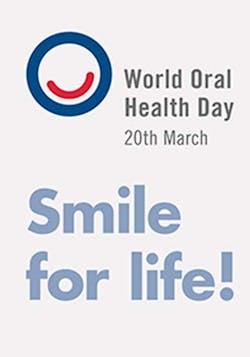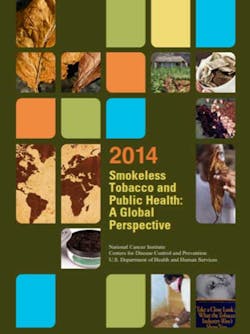Ring in the New Year by encouraging patients to quit tobacco use
The New Year always brings a sense of hope and conviction to improve our lives. New Year’s resolutions abound. With the New Year come new beginnings, fresh starts, and promises for a brighter future. We try to move on from the losses and trials of 2014, but we never forget. The people we’ve lost will be in our hearts forever, and the trials can be viewed as life lessons and opportunities.
As World Oral Health Day (WOHD) 2015 approaches, FDI World Dental Federation wants people to make a healthy New Year’s resolution and reduce their use of tobacco – or give it up completely – as part of the 2015 World Oral Health Day Smile for Life campaign.(1) Tobacco use can significantly increase the risk of many serious oral health problems, including oral cancer, periodontal disease, early tooth loss, tooth discoloration, oral malodor, and a reduced ability to taste and smell.
Dental and dental hygiene office visits can create an opportunities to help patients quit smoking and using tobacco, yet dental settings are often not used for treatment of tobacco dependence. The purpose of one study was to evaluate issues that may influence patterns of tobacco-use-related practice among a national sample of dental providers.(2) Researchers surveyed a representative sample of general dentists practicing in the U.S. More than 90% of dental providers reported that they regularly ask patients about tobacco use, 76% counsel patients, and 45% routinely offer cessation assistance. This was defined as referring patients for cessation counseling, providing a cessation prescription, or both. Results showed that cessation assistance was associated with having a practice with one or more dental hygienists, having a chart system that includes a tobacco use question, having received training on treating tobacco dependence, and having positive attitudes toward treating tobacco use.
The ADA issued a letter on “modified risk” tobacco products.(3) In a letter signed by the president and executive director, the ADA expressed to the FDA that “it is ‘virtually impossible’ to justify claims that smokeless tobacco and such newer generation products as electronic cigarettes and hookah tobacco ‘are somehow less harmful to the oral cavity than combustible tobacco products or without other adverse effects.’” The ADA strongly supports developing the published research on the latest generation of tobacco products and the short- and long-term effects of these products on oral health.
I wish all of you a happy and healthy 2015.
“A new year is like a blank book. The pen is in your hands. It is your chance to write a beautiful story for yourself. Happy New Year.”
References
1. http://www.worldoralhealthday.com/fdi-calls-for-a-tobacco-free-new-year-and-a-long-lasting-smile-for-life/.
2. Jannat-Khah DP, McNeely J, Pereyra MR, et al. Dentists’ Self-Perceived Role in Offering Tobacco Cessation Services: Results From a Nationally Representative Survey, United States, 2010–2011. Prev Chronic Dis 2014; 11:140186. http://www.cdc.gov/pcd/issues/2014/14_0186.htm.
3. ADA News. December 5, 2014. http://www.ada.org/en/publications/ada-news/2014-archive/december/ada-comments-on-modified-risk-tobacco-products.
4. National Cancer Institute and Centers for Disease Control and Prevention. Smokeless Tobacco and Public Health: A Global Perspective. Bethesda, MD: U.S. Department of Health and Human Services, Centers for Disease Control and Prevention and National Institutes of Health, National Cancer Institute. NIH Publication No. 14-7983; 2014.http://tobaksfakta.se/wp-content/uploads/2014/12/SmokelessTobaccoAndPublicHealth_AGlobalPerspective.pdf.






